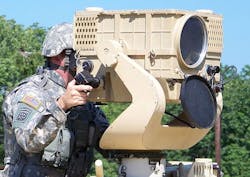Raytheon to upgrade Army electro-optical sensors with networking and anti-sniper capability
FORT BELVOIR, Va., 7 May 2015. U.S. Army electro-optics experts are asking Raytheon Co. to upgrade long-range electro-optical sensors with networking capability so soldiers can share battlefield imaging data and improve their effectiveness against enemy snipers.
Officials of the Army Contracting Command at Fort Belvoir, Va., announced a $27 million contract Wednesday to the Raytheon Integrated Defense Systems segment in McKinney, Texas, to upgrade as many as 100 Block 0 Long Range Advanced Scout Surveillance System (LRAS3) units.
Raytheon engineers will upgrade Block 0 LRAS3 second generation forward looking infrared (FLIR) systems to the Block 1 Netted LRAS3 sight sensor configuration to improve networking and situational awareness.
The LRAS3 system consists of a second-generation FLIR, TV camera, GPS interferometer, and an eye-safe laser range finder. It provides long-range target acquisition for armor and infantry scouts. The system can operate operates in stationary vehicle-mounted configurations and in an autonomous dismounted configuration.
LRAS3 provides real-time capability to detect, recognize, identify, and pinpoint far target locations during the day, at night, and in bad weather. It can be mounted either on armored ground vehicles such as the HMMWV, M1, M2, and Stryker, or used on a tripod.
The contract announced this week calls for Raytheon to provide networking for LRAS3 systems to enable operators to share information across each networked LRAS3. Upgrades also will network LRAS3 sensors with the Gunshot Detection System (GDS) for counter-sniper capability.
The GDS will provide bearing and elevation cues to the networked LRAS3 to enable the operator to identify and locate sniper locations and send target location and images to fighting forces so they can destroy the snipers.
The LRAS3 can establish a target location coordinates at about six miles with an estimated circular error probability (CEP) of about 200 feet. The system's laser rangefinder can measure range with 16-foot accuracy.
On this contract Raytheon will do the work in a variety of locations, and should be finished by May 2017. For more information contact Raytheon Integrated Defense Systems online at www.raytheon.com, or the Army Contracting Command at ..army.mil.

John Keller | Editor
John Keller is editor-in-chief of Military & Aerospace Electronics magazine, which provides extensive coverage and analysis of enabling electronic and optoelectronic technologies in military, space, and commercial aviation applications. A member of the Military & Aerospace Electronics staff since the magazine's founding in 1989, Mr. Keller took over as chief editor in 1995.

